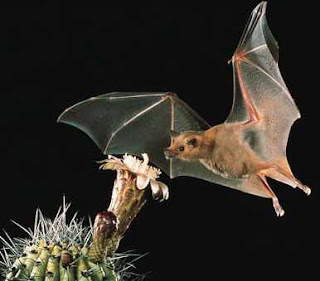 In support of National Pollinator Week, I’ve decided to showcase a pair of very welcome summer visitors to Southern Arizona, the White Winged Dove (Zenaida asiatica) and the Lesser Long-Nosed Bat (Leptonycteris yerbabuenae). These species have several things in common: they are super-pollinators, they migrate between southern Arizona and Mexico and they are both flying around in abundance in my neighborhood.
In support of National Pollinator Week, I’ve decided to showcase a pair of very welcome summer visitors to Southern Arizona, the White Winged Dove (Zenaida asiatica) and the Lesser Long-Nosed Bat (Leptonycteris yerbabuenae). These species have several things in common: they are super-pollinators, they migrate between southern Arizona and Mexico and they are both flying around in abundance in my neighborhood.Although I have lived in the Sonoran desert for many years, I have to admit that I paid very little attention to the doves around me. I had heard their calls (they are hard to miss), but I attributed most of that to Mourning Doves without giving it much thought. All that changed a little over a month ago when I opened my bedroom curtain and came face-to-face with a bird sitting on a nest. It was so close to my window that I could have reached out and touched it. In order not to disturb it, I quickly and quietly closed the curtain. But, not before surreptitiously taking a photo. I showed the picture to a co-worker who excitedly said. “That’s a White Winged Dove! They are so cool!” I
 |
| White Winged Dove Adult & Juvenile |
White Winged Doves appear in southern Arizona in late spring to begin their breeding season here. What makes them special is that they migrate at this time to correspond with the reproductive cycle of the iconic Saguaro cactus (Carnegeia gigantea). Saguaros begin flowering from late April until mid-June; fruiting and ripening take place in June and July. As soon as they get to town, White Winged Doves start visiting the saguaros. They hop from one cactus to another sipping nectar and picking at seeds until the fruit comes in and the feasting begins. It is this flitting to and fro that makes them exceptional pollinators as they fly with pollen all over them. The doves are also adept at dispersing seeds; they scatter them everywhere they go. Here is a video of them in action.
The White Winged Dove and the saguaro are a perfect example of Mutualism in nature. This is when two species depend on and benefit from each other. The doves rely nearly exclusively on the saguaro for water and nutrients and the cactus needs the birds to spread its seeds and pollen.

Lesser Long-nosed Bats travel at least 1,000 miles north from Mexico to join us here in southern Arizona for pretty much the same reasons as the dove: to have babies and take advantage of the cactus buffet. In response to the presence of these pollinators, the saguaros have generously adapted to provide for both day and night feeders. Not only do their flowers bloom at night and stay open until the afternoon of the following day, nectar is produced in the night and in the morning. There is clearly enough for everyone!
 |
| Lesser Long-nosed Bat |
 |
| Dove Love |
Submitted by Pam





No comments:
Post a Comment